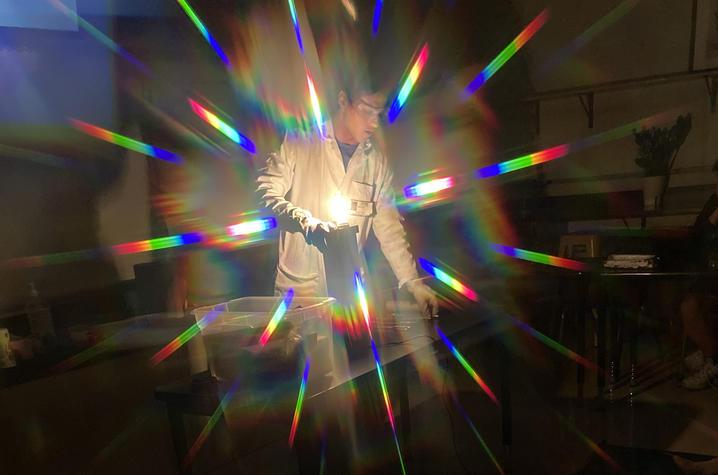
LEXINGTON, Ky. (Sept. 18, 2024) — As part of its mission to inspire the next generation of scientists and scholars, faculty and students from the University of Kentucky Department of Chemistry visit local schools to engage students with hands-on demonstrations and spark curiosity in the world around them.
This past spring, a team of four doctoral students, led by Anne-Frances Miller, Ph.D., visited an eighth-grade class at Lexington Christian Academy. Armed with such everyday materials as cabbage and hand sanitizer, the team of students — Shuvo Deb Nath, Aly Ackerman, Jessica Bone and Nolan Lok — captivated the young scientists with lessons ranging from atmospheric phenomena to the chemistry of everyday household items.
With a focus on inquiry-based learning, the students were encouraged to explore scientific concepts hands-on rather than simply hearing about them.
“Young people now spend a great deal of time online and on devices. Our in-person factual demonstrations reawaken students’ immediate excitement in the real world,” Miller said. “It is vitally important for their lives to retain that connection, because the real world is where our decisions as individuals and a society play out. Our knowledgeable and enthusiastic demonstrators show that the real world is every bit as exciting as YouTube and much more empowering.”
The lesson kicked off with an exploration of the aurora borealis, or Northern Lights. Miller explained to the class how the colors in the sky are the result of gases in the atmosphere. Lok demonstrated this with pure gases trapped in luminous tubes, showing how elements like oxygen and nitrogen emit distinct colors when excited. Students, donning prism glasses, marveled at the unique emission spectrum of each gas — a visual reminder that every element has its own “fingerprint.”

From atmospheric phenomena, the lesson shifted to chemical reactions on a molecular level. Using chopped red cabbage as a pH indicator, the team explored the properties of acids and bases. Doctoral student Deb Nath brewed up a cabbage solution that turned a vibrant indigo, before fellow student Ackerman used the liquid to test common substances. As the young students observed the cabbage juice change colors — pink for acids and green for bases — they hypothesized whether substances like lemon juice, milk, baking soda and Sprite were acidic or basic.
The interactive lesson came even more to life when students were asked to exhale into cups of cabbage juice. As the carbon dioxide from their breath turned the liquid magenta, Miller highlighted how CO2 increases acidity — a concept tied to real-world environmental issues like ocean acidification.
“Hands-on demonstrations and experiments help students reinforce knowledge in a dynamic and memorable way,” said Lexington Christian Academy teacher Jocelyn Smith. “Dr. Miller and her graduate students did an incredible job designing an engaging lesson and making connections to real-life scenarios for our students. It’s also helpful for our eighth-grade students to be exposed to college and career tracks where they can ask questions about what exciting paths exist beyond middle and high school as far as their studies and interests.”
“It was a pleasure to support an excellent teacher who is making science both fun and empowering for her class,” Miller said. “The teachers in our schools do an incredibly difficult job. I am always delighted to support them. Learning opens so many doors and greatly enriches entire lives.”
By the end of the session, the team’s demonstrations left a lasting impression — not only reinforcing the students’ classroom knowledge but also inspiring many to explore the possibilities of a career in science.
“My love for chemistry began in middle school, so I was thrilled to have the opportunity to share this passion with up-and-coming scientists,” Ackerman said. “I hope in 10 years some of these students are on the other side of the demo table having just as much fun as we did.”
As the state’s flagship, land-grant institution, the University of Kentucky exists to advance the Commonwealth. We do that by preparing the next generation of leaders — placing students at the heart of everything we do — and transforming the lives of Kentuckians through education, research and creative work, service and health care. We pride ourselves on being a catalyst for breakthroughs and a force for healing, a place where ingenuity unfolds. It's all made possible by our people — visionaries, disruptors and pioneers — who make up 200 academic programs, a $476.5 million research and development enterprise and a world-class medical center, all on one campus.
In 2022, UK was ranked by Forbes as one of the “Best Employers for New Grads” and named a “Diversity Champion” by INSIGHT into Diversity, a testament to our commitment to advance Kentucky and create a community of belonging for everyone. While our mission looks different in many ways than it did in 1865, the vision of service to our Commonwealth and the world remains the same. We are the University for Kentucky.
